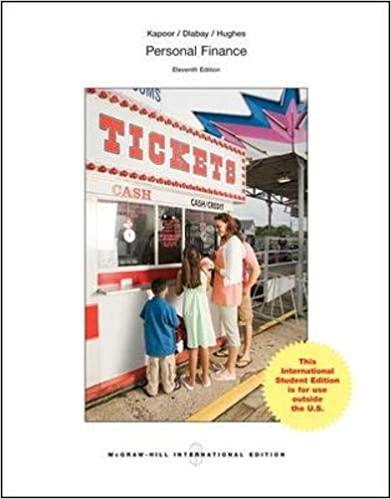Question
Billingham Packaging is considering expanding its production capacity by purchasing a new machine, the XC-750. The cost of the XC-750 is $2.72 million. Unfortunately, installing
Billingham Packaging is considering expanding its production capacity by purchasing a new machine, the XC-750. The cost of the XC-750 is $2.72 million. Unfortunately, installing this machine will take several months and will partially disrupt production. The firm has just completed a $48,000 feasibility study to analyze the decision to buy the XC-750, resulting in the following estimates: Marketing: Once the XC-750 is operating next year, the extra capacity is expected to generate $10.2 million per year in additional sales, which will continue for the ten-year life of the machine. Operations: The disruption caused by the installation will decrease sales by $5.04 million this year. As with Billingham?s existing products, the cost of goods for the products produced by the XC-750 is expected to be 72% of their sale price. The increased production will also require increased inventory on hand of $1.17 million during the life of the project. The increased production will require additional inventory of $1.17 million, to be added in year 0 and depleted in year 10. Human Resources: The expansion will require additional sales and administrative personnel at a cost of $2.07 million per year. Accounting: The XC-750 will be depreciated via the straight-line method in years 1?10. Receivables are expected to be 14% of revenues and payables to be 11% of the cost of goods sold. Billingham?s marginal corporate tax rate is 15%. a. Determine the incremental earnings from the purchase of the XC-750. b. Determine the free cash flow from the purchase of the XC-750. c. If the appropriate cost of capital for the expansion is 9.5%, compute the NPV of the purchase. d. While the expected new sales will be $10.2 million per year from the expansion, estimates range from $8.1 million to $12.3 million. What is the NPV in the worst case? In the best case? e. What is the break-even level of new sales from the expansion? What is the break-even level for the cost of goods sold? f. Billingham could instead purchase the XC-900, which offers even greater capacity. The cost of the XC-900 is $4.08 million. The extra capacity would not be useful in the first two years of operation, but would allow for additional sales in years 3-10. What level of additional sales (above the $10.2 million expected for the XC-750) per year in those years would justify purchasing the larger machine? a. Determine the incremental earnings from the purchase of the XC-750. Calculate the incremental earnings from the purchase of the XC-750 below:(Round to the nearest dollar.) Incremental Earnings Year 0 Sales Revenues $ Cost of Goods Sold $ S, G, and A Expenses $ Depreciation $ EBIT $ Taxes at 15% $ Unlevered Net Income $ (Round to the nearest dollar.) Incremental Earnings Year 1-10 Sales Revenues $ Cost of Goods Sold $ S, G, and A Expenses $ Depreciation $ EBIT $ Taxes at 15% $ Unlevered Net Income $ b. Determine the free cash flow from the purchase of the XC-750. Calculate the free cash flow from the purchase of the XC-750:(Round to the nearest dollar.) Incremental Free Cash Flow Year 0 Unlevered Net Income $ Depreciation $ Capital Expenditures $ Change in Net Working Capital $ Free cash flow $ (Round to the nearest dollar.) Incremental Free Cash Flow Year 1 Unlevered Net Income $ Depreciation $ Capital Expenditures $ Change in Net Working Capital $ Free cash flow $ (Round to the nearest dollar.) Incremental Free Cash Flow Year 2-9 Unlevered Net Income $ Depreciation $ Capital Expenditures $ Change in Net Working Capital $ Free cash flow $ (Round to the nearest dollar.) Incremental Free Cash Flow Year 10 Unlevered Net Income $ Depreciation $ Capital Expenditures $ Change in Net Working Capital $ Free cash flow $ (Round to the nearest dollar.) Incremental Free Cash Flow Year 11 Unlevered Net Income $ Depreciation $ Capital Expenditures $ Change in Net Working Capital $ Free cash flow $ c. If the appropriate cost of capital for the expansion is 9.5%, compute the NPV of the purchase. The NPV of the purchase is $ nothing. (Round to the nearest dollar.) d. While the expected new sales will be $10.2 million per year from the expansion, estimates range from $8.1 million to $12.3 million. What is the NPV in the worst case? In the best case? The NPV of the purchase for sales of $8.1 million is $ nothing. (Round to the nearest dollar.) The NPV of the purchase for sales of $12.3 million is $ nothing. (Round to the nearest dollar.) e. What is the break-even level of new sales from the expansion? The break-even level of new sales from the expansion is $ nothing. (Round to the nearest dollar.) What is the break-even level for the cost of goods sold? The break-even level for the cost of goods sold is $ nothing. (Round to the nearest dollar.) f. Billingham could instead purchase the XC-900, which offers even greater capacity. The cost of the XC-900 is $4.08 million. The extra capacity would not be useful in the first two years of operation, but would allow for additional sales in years 3-10. What level of additional sales (above the $10.2 million expected for the XC-750) per year in those years would justify purchasing the larger machine? The additional sales are $ nothing. (Round to the nearest dollar.)
Step by Step Solution
There are 3 Steps involved in it
Step: 1

Get Instant Access to Expert-Tailored Solutions
See step-by-step solutions with expert insights and AI powered tools for academic success
Step: 2

Step: 3

Ace Your Homework with AI
Get the answers you need in no time with our AI-driven, step-by-step assistance
Get Started


